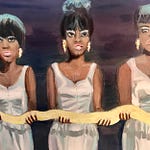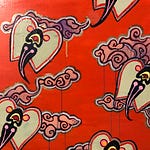SYMBOL CLASH / cintra wilson
There’s a subtle cultural proxy-war that unfolds endlessly on our bodies, and those of our friends, neighbors and countrymen. The battlefield is symbolism and the weapons are prints.
My first inkling of the importance of imagery in textiles was as a small child in the late 1970’s. I was at a play date at the home of affluent friends, when I was suddenly seized with an absorbing interest by their bold, op-art designer bath towels. (I was so impressed I lorded their label over my rube mother and her inferior linens. “Their towels,” I informed her poshly, “are by Yes Saint Lorrent.”
“Ha! It’s pronounced ‘Eve,’ not ‘Yes,’” she chortled.
(Mispronouncing the name of the designer - obviously a genius of the bath-set - was a stinging shame that I bore for years. I became obnoxiously competent at French pronunciation, if not comprehension. I finally tasted sweet revenge only recently, when ma mere botched “Ghesquiere” to my riotous derision.)
But the important thing was the print on that YSL towel set: rearranged bullseyes, not unlike Jasper Johns’ “Target with Plaster Casts” -- but cut-up, like a William S. Burroughs novel, and wrought in Egyptian cotton in that season’s fashionable turquoise and fuchsia.
It took those bullseyes twenty years to travel from the avant-garde art gallery to the bourgeoisie guest bathroom -- a journey which completely exhausted the imagery of all the shock it once inspired. The “trickle-down theory” may be a risible economic model, but it’s a safe bet that whatever cutting-edge styles and shapes the avant garde curators are fetishizing now will end up a nine-piece sheet set, 30% off at a mid-range white sale somewhere in the not-too-distant future.
Prints undergo many changes during their journey from the canvases of the hip and profligate to the laundry baskets of the Connecticut matron, as any look into a 1970's suburban mail-order catalog will reveal. One must bear in mind that the muttonchopped man in yellow plaid pants wasn’t always a punchline -- he was hip, once. He was the wife-stealing Cassanova of the country club before mass production stole his flair, turned it out viral in Dacron and rendered him the type of guy who sells wholesale waterbeds. His pants were originally intended to epater la bourgeoisie, not add a pop of color to your drapes.
Take the recent recrudescence of the bejeweled caftan, a style which began amid the Haute Volée – tax exiles and jet-setters - hanging around in Tangiers after Morocco declared independence in 1956. Artists, writers, and drug fiends of all sexual proclivities followed: Paul Bowles, William S. Burroughs, Jack Kerouac, Allan Ginsburg, the Rolling Stones. The spirit of 1960’s Marrakech was epitomized by a Patrick Litchfield shot of Talitha Getty, diaphanous and dishabille on her roof deck among the domes. The caftan declared allegiance with an artistic, kif-smoking, lotus-eating, louche and sexually adventurous set of beautiful people and heavy thinkers, who were getting high among the tiles and returning to swinging London spangled like gypsy Christmas trees in cheap silver tribal jewelry, beads, berber rugs and enough sheepskin objets to recreate an opium den back in Leicester Square.
Today, no more decadence remains in the caftan - the Tunisians have been conveniently tweezed out of the Tory Burch tunic. The kicky Moorish influences occasionally found in the offerings of today's young professional hipster furniture showrooms -- leather poufs, geometric light-shades - were once inspired by Islamic tiles, but the designs have been politely de-Islamated for your protection, and now are 50% less Moorish - sending a Demi-Moorish signal, if you will -- a de-opinionated opium den look for the aspirational loft-dwelling crowd.
Punk rock and bondage suffered a similar loss of sartorial meaning. In Style Wars, Peter York talks about the excitement when punk exploded onto a music scene that had been waiting for something to happen for a decade. “The OK subjects now certainly weren’t sex or love, for that was tedious and middlebrow, but the dole queue, boredom, urban violence, and perversity...It was Jean Genet and J.G. Ballard all in one,” he wrote. Soon enough, the big record labels were able to de-politicize and dilute the meanings introduced by seminal bands like the Clash and the Sex Pistols into dumber bands with lesser messages but greater commodification - what York describes as “Pepsi-punk" (designer Reed Krakoff introduced "luxe-punk" to Madison Avenue - the ultimate sartorial oxymoron).
Even the durable Goth style has been defanged and lost its original death-drive. When Paris designers began dishing out 7-inch black-buckled bondage pleasers of a variety once worn exclusively by vampire sex workers, there was certainly still sex in them -- they still winked like naughty shoes -- but the cost and quality of them removed the danger. It was the footwear of the demimondaine, without the edgy aftertaste, tragic consequences, or that dirty feeling they felt when the dawn crept in. Even the skull-print has become fodder for toddler bibs.
What begins as a declaration of symbolic class warfare -- a gob in the establishment’s eye from an audience of disaffected youth – gets trendy, co-opted and mass-produced. The symbols of social transgression inevitably become the hand towels of colonialism. Patterns may endure, but the symbolism swings (as London did, when Roger Miller sang about it in 1965) “like a pendulum do.” The meaning of the sign is destabilized; the patterns roll through time losing a bit of that original suction every year, and ultimately, mean nothing at all.














Share this post